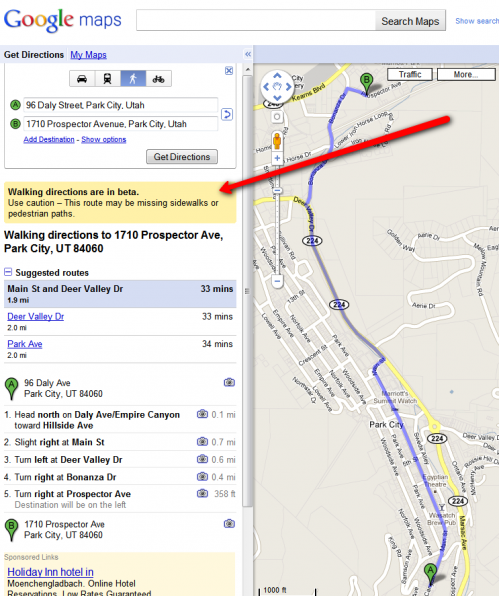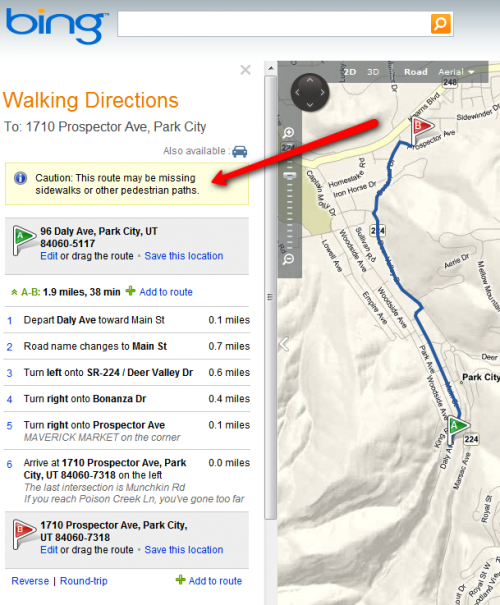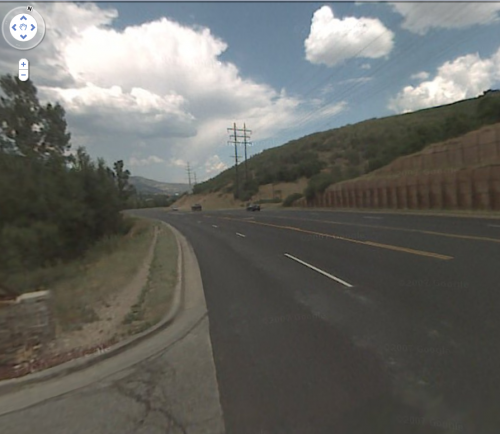Woman Follows Google Maps “Walking” Directions, Gets Hit, Sues
Is Google responsible for giving out bad directions through its Google Maps service? We’re about to find out. After Googling walking directions for a trip in Park City, Utah, Lauren Rosenberg claims she was led onto a busy highway, where she was struck by a vehicle. She’s now suing Google for damages. The case, Rosenberg […]
Is Google responsible for giving out bad directions through its Google Maps service? We’re about to find out. After Googling walking directions for a trip in Park City, Utah, Lauren Rosenberg claims she was led onto a busy highway, where she was struck by a vehicle. She’s now suing Google for damages.
The case, Rosenberg v. Harwood, was filed in Utah, in the US District Court’s Central Division (Gary Price of ResourceShelf tipped us to it today). Harwood is Patrick Harwood, the person who actually hit Rosenberg, according to the suit. Both Harwood and Google are being sued in the same case, for damages “in excess of $100,000.”
Rosenberg used Google Maps on January 19, 2009, via her Blackberry, to get directions between 96 Daly Street, Park City, Utah and 1710 Prospector Avenue, Park City, Utah. Google provided these, telling her as part of the route to walk for about 1/2 mile along the calm-sounding “Deer Valley Drive.”
That’s an alternative name for that section of Utah State Route 224, a highway that lacks sidewalks, the case says. Rosenberg wasn’t warned about this, putting Google directly at fault in the accident, the case claims:
Defendant Google, through its “Google Maps” service provided Plaintiff Lauren Rosenberg with walking directions that led her out onto Deer valley Drive, a.k.a. State Route 224, a rural highway wit no sidewalks, and a roadway that exhibits motor vehicles traveling at high speeds, that is not reasonably safe for pedestrians.
The Defendant Google expects uses of the walking map site to rely on the accuracy of the walking directions given….
As a direct and proximate cause of Defendant Google’s careless, reckless, and negligent providing of unsafe directions, Plaintiff Laren Rosenberg was led onto a dangerous highway, and was thereby stricken by a motor vehicle…
Here’s the route:
In the screenshot above, you can see that Google quite clearly warns:
Walking directions are in beta.
Use caution – This route may be missing sidewalks or pedestrian paths.
That would seem to negate part of the suit’s claim — except that Rosenberg used a Blackberry. The Blackberry version of Google Maps might not have carried this warning. I don’t have a Blackberry so can’t see myself, but I’m checking on this. I know that on the iPhone version, there is no warning.
Certainly it seems embarrassing for Google to be routing people onto busy highways when they explicitly use the “walking” directions option. But then again, Google’s not alone. Bing does the same thing in its directions, which also contain a warning (at least in the web version):
Part of the issue seems to be that there’s no easy-to-find pedestrian path between these two points in Park City. Looking at the satellite view on Google Maps, there appears to be an alternative dirt path that runs roughly along the same direction. But I can’t tell if this was open to public use or not. Since it’s not along a major road, it’s something that Google Maps probably didn’t pick up.
Instead, Google’s making its best guess. That can be laughable to annoying, when it gets things wrong. Some examples:
- Google used to advise swimming across the Atlantic Ocean to get from the US to Britain, as a joke
- Google, before walking directions were added in July 2008, took a lot of ribbing for turning a 30 second walk in Sydney into an 18 minute car trip
- When Google Maps rolled out its new bike directions feature in March, I found in my area, it made some wildly bad guesses
But are Google’s bad guesses also dangerous? I suspect a court is going to find that despite getting bad directions from Google (or a gas station attendant, a local person or any source), people are also expected to use common sense. So when you come to an intersection like this, as Rosenberg would have come to before crossing onto the highway:
You might be expected to consider for yourself whether it is safe to continue. Or when you’re walking down the road itself, and it looks like this:
It becomes self-evident there’s no sidewalk and probably not a good place for pedestrians to walk, regardless of whether you got a warning from Google or not.
Here’s to Google improving its directions and perhaps using more common sense of its own, understanding whether a street is a busy highway and maybe simply not offering routes when it doubt, rather than guessing.
And here’s also to common sense about anyone following any directions they’re given.
Here’s a copy of the filing, which we’ve uploaded to Scribd:
Rosenberg v. Harwood (& Google)
I’ve also asked Google and the law firm for comment. The lead lawyer on the case is out until Tuesday, I was told when I call, so I’ll post any information I get from them from that day onward.
Postscript (June 1, 2:45PM PT): Lauren Rosenberg of Santa Monica dropped me an email begging to get the word out that she’s NOT the Lauren Rosenberg involved in this suit. Lauren of Santa Monica is getting flooded with press calls, she told me.
Postscript (June 1, 4:40PM PT): See our update, Attorney In Google Maps Lawsuit: It Was Dark; She Thought Google Was Leading Her To Sidewalk.
Contributing authors are invited to create content for Search Engine Land and are chosen for their expertise and contribution to the search community. Our contributors work under the oversight of the editorial staff and contributions are checked for quality and relevance to our readers. The opinions they express are their own.
Related stories



